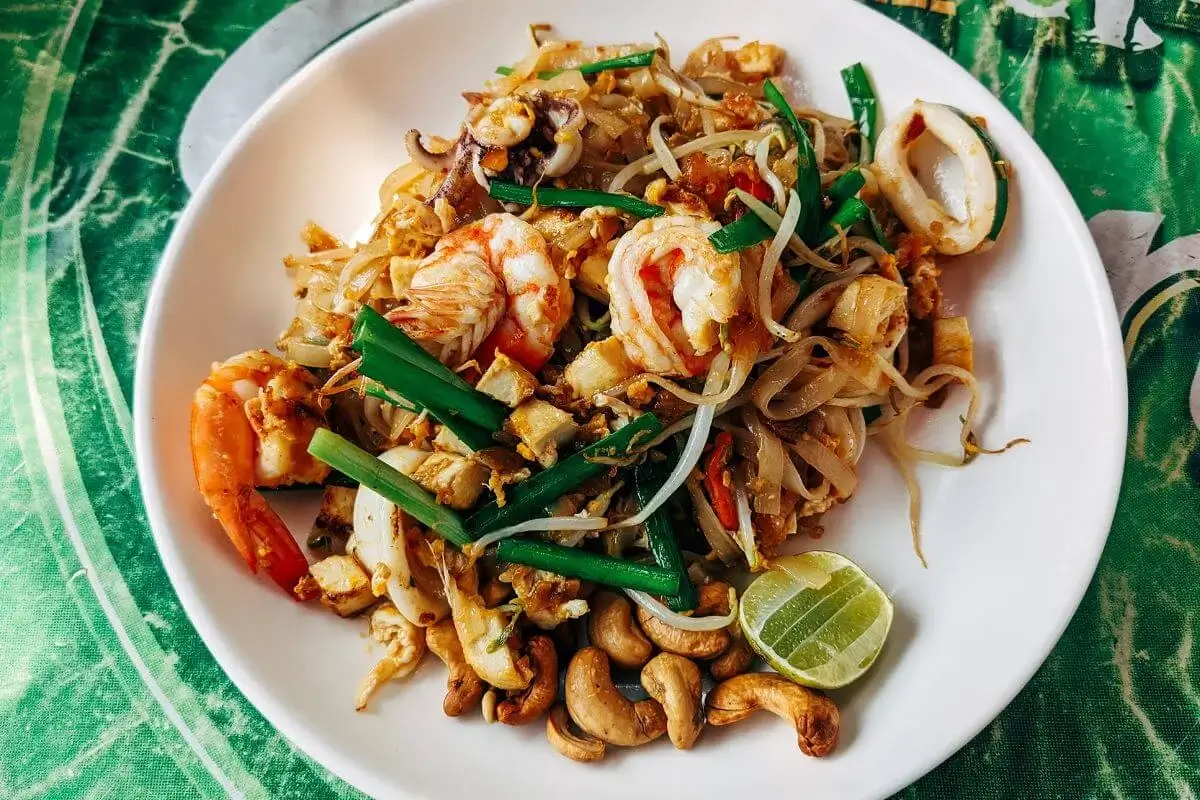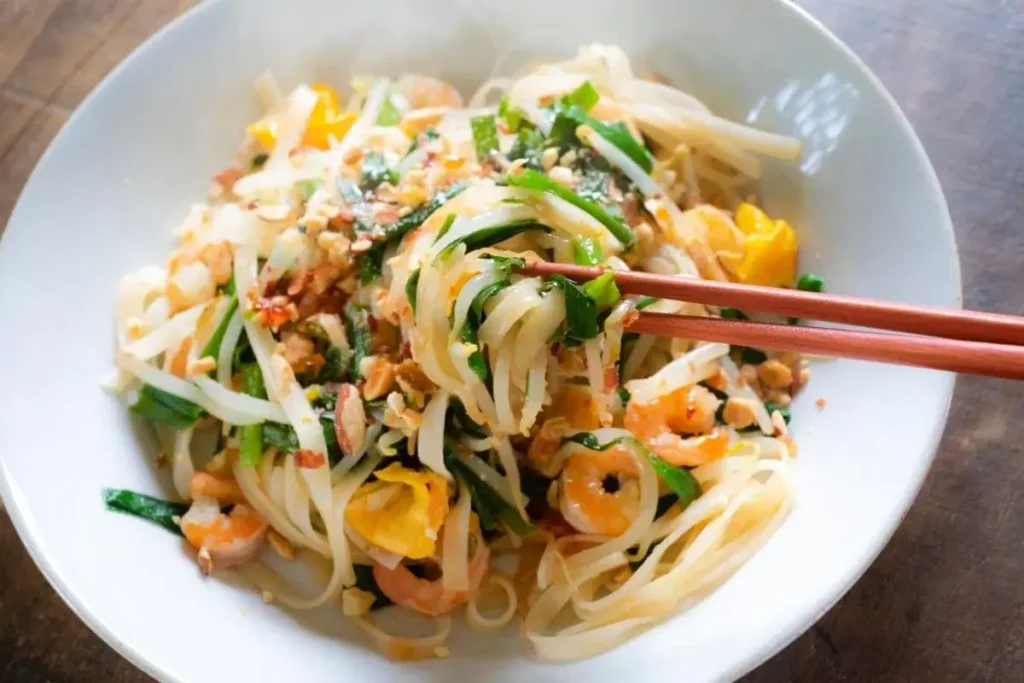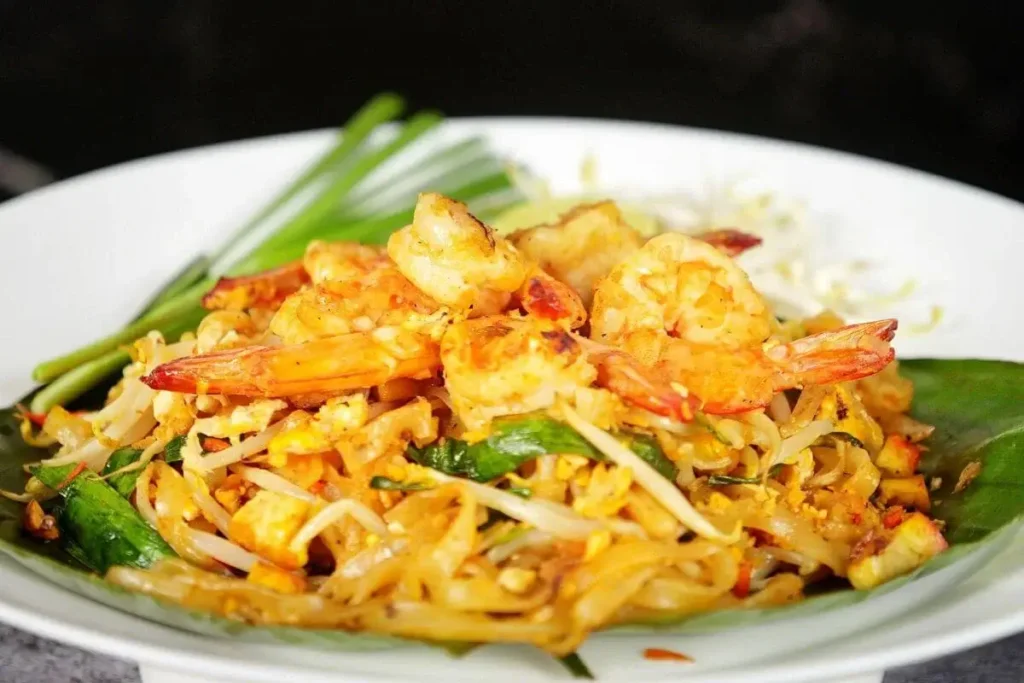Discover the Phat Si-Io recipe, a renowned Thai dish featuring stir-fried noodles that captivate taste buds globally. This guide covers both traditional and adapted recipes, ensuring everyone can enjoy this culinary gem. From selecting ingredients to mastering caramelization techniques, it equips you to recreate this Thai classic at home. Follow along to transform simple ingredients into a spectacular meal that’s both nourishing and bursting with authentic flavors.
Introduction to Phat Si-Io
What is Phat Si-Io?
Phat Si-Io, a Thai stir-fried noodles dish, boasts robust flavors and a straightforward cooking method. Originating from Thailand’s bustling street food scene, it has gained global popularity in Thai eateries worldwide. Transitioning from the streets to restaurant menus, Phat Si-Io captivates diners with its perfect blend of sweet, sour, and salty flavors. Its rapid cooking technique over high heat ensures a unique smoky essence.
Moreover, Phat Si-Io’s versatility allows for endless customization. Whether with chicken, beef, or shrimp, protein options abound.
To achieve authentic flavors, a delicate balance of ingredients is paramount. Sweetness from sugar, tanginess from vinegar, and saltiness from soy sauce meld seamlessly together.
Moving to the cooking process, Phat Si-Io demands quick and vigorous stir-frying. This technique caramelizes noodles without compromising their texture.
Traditionally served simply, Phat Si-Io highlights the noodles and greens. It’s enjoyed with a fork or spoon, the preferred utensils in Thailand.
For a modern twist, serving Phat Si-Io in a pre-heated cast-iron skillet enhances its rustic appeal. It keeps the noodles warm and elevates the presentation. Going from the streets of Thailand to your kitchen, Phat Si-Io offers a taste of authentic Thai cuisine. Prepare it at home for a delightful culinary adventure.
In conclusion, Phat Si-Io’s popularity transcends borders, delighting palates worldwide. Its robust flavors and simple cooking process make it a cherished dish in Thai cuisine.
Key Ingredients in Traditional Phat Si-Io Recipe
The foundation of any authentic Phat Si-Io recipe includes wide, flat rice noodles known as Sen Yai. The noodles are pivotal, providing a satisfying chewiness when cooked perfectly. Traditionally, these ingredients are stir-fried together, coated in a flavorful sauce comprising dark soy sauce, oyster sauce (which adds essential umami notes), a hint of sugar, and vinegar for a subtle tang. Alongside, fresh components such as Chinese broccoli, eggs, and chicken (or alternative proteins) are incorporated, lending both texture and complexity to the dish. Collectively, these components fuse seamlessly, embodying the authentic essence of Phat Si-Io.
Moving from the roots of Phat Si-Io to its preparation, the next part guides you through ingredient selection and cooking steps. Stay tuned as we explore making Phat Si-Io accessible and enjoyable for all, regardless of dietary restrictions.
Preparing Phat Si-Io Recipe
Choosing the Right Ingredients
When adapting Phat Si-Io recipe for a diet, it’s crucial to select ingredients that align with standards, ensuring that every element of the dish is permissible. The noodles and vegetables remain unchanged; however, the protein choices require careful consideration. Instead of traditional pork, opt for chicken, beef, or even tofu for a vegetarian twist. Each of these alternatives wonderfully absorbs the rich flavors of the sauce while maintaining the dish’s authentic texture.
Selecting Noodles and Vegetables
For the noodles, wide, flat rice noodles are ideal as they provide the perfect surface area to cling to the sauces and pick up the wok’s high heat — essential for that coveted smokey flavor. If Sen Yai noodles are unavailable, dried rice stick noodles can be a practical substitute without compromising taste or texture.
As for vegetables, Chinese broccoli (Gai Lan) is traditional. However, if it’s not available, other leafy greens like bok choy or broccolini can be excellent substitutes. These vegetables should be fresh and crisp to add a bright, slightly crunchy contrast to the soft noodles.
Protein Options for Phat Si-Io
While chicken is the go-to protein for Phat Si-Io, beef or shrimp are viable options too. Thigh pieces are ideal for chicken due to their juiciness. Marinate the protein in light soy sauce and white pepper for added flavor depth. This ensures each bite of Phat Si-Io is rich and flavorful
Step-by-Step Cooking Guide
Creating Phat Si-Io recipe in your kitchen involves a two-part cooking process that focuses on preserving the integrity of the noodles while building layers of flavor.
Preparing the Noodles and Vegetables
Begin by preparing the noodles according to package instructions, usually involving soaking or boiling until just tender. Drain and set aside, ensuring they don’t stick together. Prep your vegetables by washing and cutting the Chinese broccoli into manageable pieces, separating the leaves from the thicker stems, as the stems take a bit longer to cook.
Cooking Techniques for Perfect Caramelization
Heat a large wok or skillet over high heat and add a swirl of vegetable oil. Start by stir-frying your chicken or other proteins until they’re just cooked through. Remove them from the wok and set aside. In the same wok, add a bit more oil, then toss in the garlic to fry until golden, followed swiftly by the Chinese broccoli stems. Once these have softened slightly, add the leaves to wilt.
Next, push the vegetables to one side of the wok and pour in the beaten eggs, scrambling them until just set. Quickly reintroduce the protein to the wok, mixing well. Now, add the drained noodles and pour over the prepared sauce, which includes dark soy sauce, oyster sauce, vinegar, and a sprinkle of sugar to balance the flavors. The key is to stir-fry the mixture quickly and vigorously, allowing the edges of the noodles to caramelize without breaking them down. This technique mimics the high heat of Thai street food stalls and brings out the signature smokiness of Phat Si-Io.
Continuing our journey into the intricacies of Phat Si-Io, the following section will focus on mastering the sauce and the various adjustments you can make to personalize it. This is the crucial step where basic components transform into a dish brimming with taste and cultural heritage.
Enhancing Your Phat Si-Io Recipe
Sauce Variations and Seasoning
The sauce is the soul of any Phat Si-Io dish, enveloping the noodles and fillings in its rich, savory, and slightly sweet embrace. Getting the sauce right means striking a delicate balance between the salty depth of soy sauce and the umami punch of oyster sauce, with just enough sugar to counteract the sharpness of the vinegar.
Making the Perfect Phat Si-Io Sauce
To start, blend two teaspoons of dark soy sauce, known for its deep color and robust flavor, with one and a half tablespoons of oyster sauce to add complexity and richness. Then, incorporate a tablespoon of light soy sauce for its salty taste, complemented by two teaspoons of plain white vinegar for acidity. Finally, integrate two teaspoons of sugar to create a harmonious fusion of flavors that define a classic Phat Si-Io. This sauce can be adjusted to taste; some might prefer a touch more sweetness or a sharper vinegar kick.
Adjusting Flavors to Taste
Taste as you cook, which is a cornerstone of Thai cooking philosophy. Adjust the sauce according to your preferences—perhaps a bit more sugar if you like it sweeter, or an additional splash of soy sauce for those who favor a saltier dish. Remember, the key to an exceptional Phat Si-Io lies in its balance of flavors, so each adjustment should be made thoughtfully and sparingly.
Serving and Presentation Tips
Presentation plays a significant role in the enjoyment of Phat Si-Io, transforming this humble noodle dish into a feast for the eyes.
Traditional vs. Modern Serving Styles
Traditionally, Phat Si-Io is served plainly, accentuating noodles and greens. It’s often enjoyed with a fork or spoon, typical utensils in Thailand. To add a modern twist, serve it in a pre-heated cast-iron skillet. This enhances its rustic appeal and keeps it warm. Additionally, garnish with fresh herbs for a burst of flavor. Moreover, consider serving with a side of lime wedges for added acidity. Furthermore, you can customize toppings to suit your taste preferences. Experiment with crushed peanuts, bean sprouts, or sliced chilies. Alternatively, drizzle with a squeeze of lime juice or a splash of fish sauce. Transitioning to plating, arrange the noodles elegantly, creating a visually appealing presentation. Finally, serve immediately to enjoy the dish at its best.
Complementary Side Dishes
While Phat Si-Io can stand alone as a fulfilling meal, it pairs wonderfully with a range of side dishes. A light, crisp Asian slaw or a fresh cucumber salad can offer a refreshing contrast to the dish’s hearty warmth. For those looking to round out the meal, consider adding a simple clear soup, such as a Tom Yum without shrimp, to cleanse the palate between bites of rich, savory noodles.
As we continue, the next section will delve into the nutritional aspects of Phat Si-Io, providing insights into how this beloved dish can fit into a healthy, balanced diet. Stay tuned to uncover how you can enjoy Phat Si-Io not only for its taste but also for its nutritional benefits.
Nutritional Information of Phat Si-Io
Phat Si-Io is not only delicious but can also be adapted to meet various dietary needs, making it a versatile dish for health-conscious individuals. Understanding the nutritional content helps in making informed choices that align with your dietary goals.
Caloric Content and Health Benefits
Typically, Phat Si-Io is moderately high in calories, primarily due to the noodles and oils used in stir-frying. By tweaking ingredients, like using less oil or leaner meats, you can cut calories without losing taste. The inclusion of vegetables like Chinese broccoli adds essential vitamins and minerals, enhancing the dish’s overall nutritional profile. These greens are rich in Vitamin A and Vitamin C, while also providing fiber which is crucial for digestive health.
Adapting the Recipe for Dietary Needs
For those managing dietary restrictions, Phat Si-Io offers flexibility. Gluten-free diners can use gluten-free soy sauce instead of the standard version to maintain authenticity. For vegetarians, skipping chicken and adding more vegetables or tofu can create a flavorful, protein-packed alternative. Each ingredient in Phat Si-Io can be adjusted to accommodate health considerations, ensuring that the dish remains a guilt-free pleasure.
FAQs About Phat Si-Io Recipe
What is Pad See Ew made of?
Pad See Ew, a dish similar to Phat Si-Io, typically consists of wide rice noodles stir-fried with soy sauce, a protein like chicken, or beef, and Chinese broccoli. The key to its flavor lies in the caramelization of the ingredients, achieved through high-heat cooking.
What’s the difference between Pad See Ew and drunken noodles?
Pad See Ew boasts a sweet and savory taste profile, characterized by soy sauce and sugar, while Drunken noodles offer a spicier alternative, incorporating basil and a blend of soy and oyster sauces.
How to cook instant snail noodle?
In various parts of Asia, people typically prepare instant snail noodles by boiling the noodles and then adding seasonings, which include a savory broth and often a spicy component.
Is pad thai healthy?
Pad Thai can be part of a healthy diet if prepared thoughtfully. Traditionally made with rice noodles, eggs, tofu, and various seasonings, it offers a balanced mix of carbohydrates, protein, and fats. Opting for less oil and sugar can make it a healthier option.
Phat Si-Io blends Thai culinary traditions with modern dietary needs, offering nourishment and flavor. Enjoy it for family dinners or exploring Thai cuisine at home.
Wrapping Up Our Culinary Journey
Embrace traditional preparation methods and healthful tweaks to bring authentic Thai taste to your kitchen. Whether for flavor, health, or both, Phat Si-Io offers a fulfilling homemade version of Thai street food.
Keep in mind that cooking thrives on exploration and individualization. So, take these guidelines and tips as your starting point and feel free to adjust the spices, ingredients, and cooking methods to suit your taste and dietary preferences. Here’s to many delightful meals ahead, filled with the joy of cooking and the pleasure of sharing good food. Enjoy your culinary adventure with Phat Si-Io!



